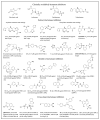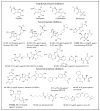Drug Discovery in the Field of β-Lactams: An Academic Perspective
- PMID: 38247618
- PMCID: PMC10812508
- DOI: 10.3390/antibiotics13010059
Drug Discovery in the Field of β-Lactams: An Academic Perspective
Abstract
β-Lactams are the most widely prescribed class of antibiotics that inhibit penicillin-binding proteins (PBPs), particularly transpeptidases that function in peptidoglycan synthesis. A major mechanism of antibiotic resistance is the production of β-lactamase enzymes, which are capable of hydrolyzing β-lactam antibiotics. There have been many efforts to counter increasing bacterial resistance against β-lactams. These studies have mainly focused on three areas: discovering novel inhibitors against β-lactamases, developing new β-lactams less susceptible to existing resistance mechanisms, and identifying non-β-lactam inhibitors against cell wall transpeptidases. Drug discovery in the β-lactam field has afforded a range of research opportunities for academia. In this review, we summarize the recent new findings on both β-lactamases and cell wall transpeptidases because these two groups of enzymes are evolutionarily and functionally connected. Many efforts to develop new β-lactams have aimed to inhibit both transpeptidases and β-lactamases, while several promising novel β-lactamase inhibitors have shown the potential to be further developed into transpeptidase inhibitors. In addition, the drug discovery progress against each group of enzymes is presented in three aspects: understanding the targets, screening methodology, and new inhibitor chemotypes. This is to offer insights into not only the advancement in this field but also the challenges, opportunities, and resources for future research. In particular, cyclic boronate compounds are now capable of inhibiting all classes of β-lactamases, while the diazabicyclooctane (DBO) series of small molecules has led to not only new β-lactamase inhibitors but potentially a new class of antibiotics by directly targeting PBPs. With the cautiously optimistic successes of a number of new β-lactamase inhibitor chemotypes and many questions remaining to be answered about the structure and function of cell wall transpeptidases, non-β-lactam transpeptidase inhibitors may usher in the next exciting phase of drug discovery in this field.
Keywords: cell wall transpeptidase; peptidoglycan; resistance mechanisms; β-lactam; β-lactamase; β-lactamase inhibitor.
Conflict of interest statement
The authors declare no conflicts of interest.
Figures





Similar articles
-
β-Lactam antibiotic targets and resistance mechanisms: from covalent inhibitors to substrates.RSC Med Chem. 2021 Aug 4;12(10):1623-1639. doi: 10.1039/d1md00200g. eCollection 2021 Oct 20. RSC Med Chem. 2021. PMID: 34778765 Free PMC article. Review.
-
β-lactam resistance: The role of low molecular weight penicillin binding proteins, β-lactamases and ld-transpeptidases in bacteria associated with respiratory tract infections.IUBMB Life. 2018 Sep;70(9):855-868. doi: 10.1002/iub.1761. Epub 2018 May 2. IUBMB Life. 2018. PMID: 29717815 Review.
-
Structural Characterization of Diazabicyclooctane β-Lactam "Enhancers" in Complex with Penicillin-Binding Proteins PBP2 and PBP3 of Pseudomonas aeruginosa.mBio. 2021 Feb 16;12(1):e03058-20. doi: 10.1128/mBio.03058-20. mBio. 2021. PMID: 33593978 Free PMC article.
-
The Penicillin-Binding Protein PbpP Is a Sensor of β-Lactams and Is Required for Activation of the Extracytoplasmic Function σ Factor σP in Bacillus thuringiensis.mBio. 2021 Mar 23;12(2):e00179-21. doi: 10.1128/mBio.00179-21. mBio. 2021. PMID: 33758089 Free PMC article.
-
OP0595, a new diazabicyclooctane: mode of action as a serine β-lactamase inhibitor, antibiotic and β-lactam 'enhancer'.J Antimicrob Chemother. 2015 Oct;70(10):2779-86. doi: 10.1093/jac/dkv166. Epub 2015 Jun 18. J Antimicrob Chemother. 2015. PMID: 26089439
Cited by
-
The global resistance problem and the clinical antibacterial pipeline.Nat Rev Microbiol. 2025 Aug;23(8):491-508. doi: 10.1038/s41579-025-01169-8. Epub 2025 Apr 10. Nat Rev Microbiol. 2025. PMID: 40210708 Review.
-
Decarboxylation of the Catalytic Lysine Residue by the C5α-Methyl-Substituted Carbapenem NA-1-157 Leads to Potent Inhibition of the OXA-58 Carbapenemase.ACS Infect Dis. 2024 Dec 13;10(12):4347-4359. doi: 10.1021/acsinfecdis.4c00671. Epub 2024 Nov 27. ACS Infect Dis. 2024. PMID: 39601221 Free PMC article.
-
Combining MicroED and native mass spectrometry for structural discovery of enzyme-small molecule complexes.Proc Natl Acad Sci U S A. 2025 Aug 5;122(31):e2503780122. doi: 10.1073/pnas.2503780122. Epub 2025 Jul 28. Proc Natl Acad Sci U S A. 2025. PMID: 40720654 Free PMC article.
-
Global health perspectives on antibacterial drug discovery and the preclinical pipeline.Nat Rev Microbiol. 2025 Aug;23(8):474-490. doi: 10.1038/s41579-025-01167-w. Epub 2025 Mar 27. Nat Rev Microbiol. 2025. PMID: 40148602 Review.
-
Hybrid Metal Catalysts as Valuable Tools in Organic Synthesis: An Overview of the Recent Advances in Asymmetric C─C Bond Formation Reactions.Molecules. 2024 Oct 28;29(21):5090. doi: 10.3390/molecules29215090. Molecules. 2024. PMID: 39519731 Free PMC article. Review.
References
Publication types
Grants and funding
LinkOut - more resources
Full Text Sources

